The Tokugawa (or Edo) period brought 250 years of stability to Japan. The political system evolved into what historians callbakuhan, a combination of the terms bakufu and han (domains) to describe the government and society of the period.[1] In the bakuhan, the shogun had national authority and the daimyo had regional authority. This represented a new unity in the feudal structure, which featured an increasingly large bureaucracy to administer the mixture of centralized and decentralized authorities. The Tokugawa became more powerful during their first century of rule: land redistribution gave them nearly seven million koku, control of the most important cities, and a land assessment system reaping great revenues.
During the period, Japan progressively studied Western sciences and techniques (called rangaku, "Dutch studies") through the information and books received through the Dutch traders in Dejima. The main areas that were studied included geography, medicine, natural sciences, astronomy, art, languages, physical sciences such as the study of electrical phenomena, and mechanical sciences as exemplified by the development of Japanese clockwatches, or wadokei, inspired by Western techniques.
The flourishing of Neo-Confucianism was the major intellectual development of the Tokugawa period. Confucian studies had long been kept active in Japan by Buddhist clerics, but during the Tokugawa period, Confucianism emerged from Buddhist religious control. This system of thought increased attention to a secular view of man and society. The ethical humanism, rationalism, and historical perspective of neo-Confucian doctrine appealed to the official class. By the mid-17th century, neo-Confucianism was Japan's dominant legal philosophy and contributed directly to the development of the kokugaku (national learning) school of thought.
For the first time, urban populations had the means and leisure time to support a new mass culture. Their search for enjoyment became known as ukiyo (the floating world), an ideal world of fashion, popular entertainment, and the discovery of aesthetic qualities in objects and actions of everyday life, including sex (shunga). This increasing interest in pursuing recreational activities helped to develop an array of new industries, many of which could be found in an area known as Yoshiwara. The region was better known for being the center of Edo’s developing sense of elegance and refinement. This place of pleasure and luxury became a destination for the elite and wealthy merchants who wished to flaunt their fortune.[10] Their economy relied primarily on the patronage of such individuals in order to sustain itself. For many of those who inhabited and worked in this region maintaining the illusion of grandeur was the only way of supporting their business.
Professional female entertainers (geisha), music, popular stories, Kabuki and bunraku (puppet theater), poetry, a rich literature, and art, exemplified by beautiful woodblock prints (known as ukiyo-e), were all part of this flowering of culture. Literature also flourished with the talented examples of the playwright Chikamatsu Monzaemon (1653–1724) and the poet, essayist, and travel writer Matsuo Bashō (1644–94).
Here there are some art products from the Edo Period:
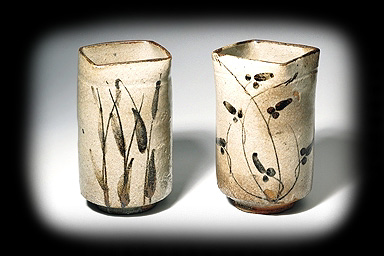
Two Mukozuke Dishes
Saga and Nagasaki Prefectures
Momoyama to Edo period, late 16th-early 17th
century
Stoneware painted with underglaze iron brown
(Karatsu ware)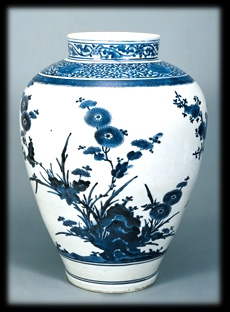
Storage Jar
Saga Prefecture
Edo period, c. 1670-1690
Porcelain painted with underglaze cobalt blue
(Arita ware, Kakiemon style)
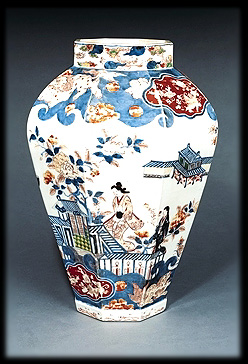
Octagonal Jar
Saga Prefecture
Edo period, 18th century
Porcelain painted with underglaze cobalt blue
and overglaze enamels, with traces of gold (Arita ware, Imari style
)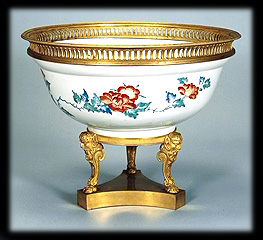
Bowl
Saga Prefecture
Edo period, c. 1670-1690
Porcelain painted with overglaze enamels, with traces of gold (Arita ware, Kakiemon style); 18th-century gilt bronze mounts
Saga Prefecture
Edo period, c. 1670-1690
Porcelain painted with overglaze enamels, with traces of gold (Arita ware, Kakiemon style); 18th-century gilt bronze mounts

Poem Scroll
Calligraphy by Hon'ami Koetsu (1558-1637)
Painting by a follower of Tawaraya Sotatsu
Poem Scroll with Selections from the Anthology
of Chinese and Japanese Poems for Recitation (Wakan roei shu)
Edo period, dated 1626
Handscroll; ink and gold on silk
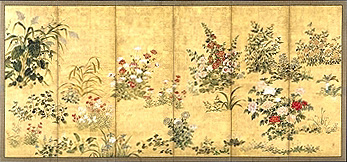
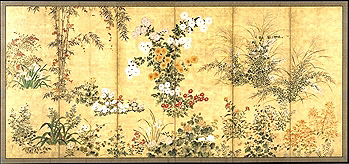
Sotatsu School Screens
Attributed to Sotatsu School
Flowers and Grasses of the Four Seasons
Edo period, c. 1620-1650
Pair of six-panel folding screens; color and
ink on gold leaf on paper
Mr. and Mrs. John D. Rockefeller 3rd
Acquisition Fund
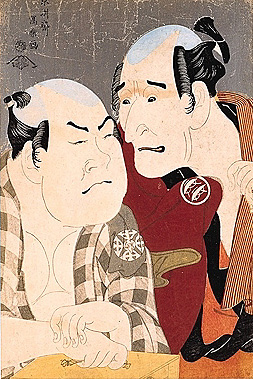
Toshusai Sharaku (active 1794-1795)
Nakamura Konozo as the Boatman Kanagawaya no
Gon and Nakajima Wadaemon as "Dried Codfish" Chozaemon
Edo period, 1794-1795
Woodblock print; ink, color, and mica on paper
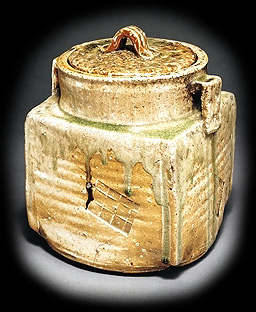
Water Jar for Tea Ceremony
Mie Prefecture
Momoyama to Edo period, late 16th-early 17th
century
Stoneware with impressed design under glaze
(Iga ware)
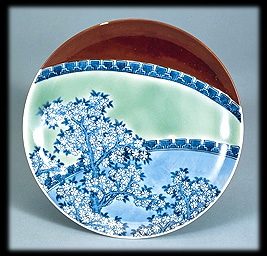
Nabeshima Dish
Saga Prefecture
Edo period, 17th century
Porcelain painted with underglaze cobalt blue
with iron-brown and green glazes (Arita ware, Nabeshima type)
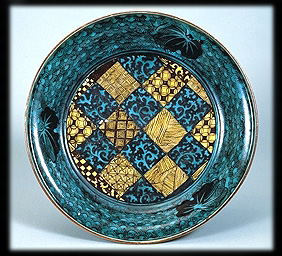
Kutani Dish
Shallow Bowl
Saga Prefecture
Edo period, late 17th-early 18th century
Porcelain painted with overglaze enamels (Arita
ware, Kutani style)
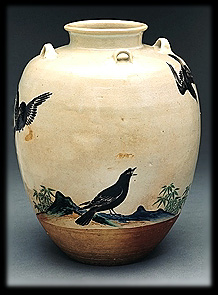
Ninsei Jar
Nonomura Ninsei (about 1574-1660/66)
Tea Leaf Jar
Kyoto Prefecture
Edo period, mid-17th century
Stoneware painted with overglaze enamels and
silver (Kyoto ware)
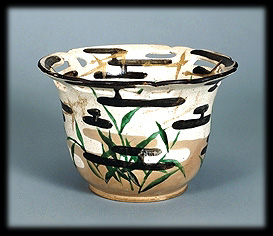
Kenzan Bowl
Ogata Kenzan (1663-1743)
Bowl with Reticulated Rim
Kyoto Prefecture
Edo period, early 18th century
Stoneware with pierced design and painted with
slips under glaze and overglaze enamels and gold (Kyoto ware)
![A Three-Tiered Jubako [Food Containter] Edo Period (17th century) Decorated in gold and silver hiramaki-e, takamaki-e and nashiji on a black ground, the top with a pagoda in a rocky moonlit landscape within a kidney-shaped panel bordered by shippo-hanabishi, the other tiers each with a different design of shells, figures in a rural landscape, and plants behind a brushwork fence, red lacquer interior 20cm. high:](https://s-media-cache-ak0.pinimg.com/736x/d3/e9/9e/d3e99e89fd228f07cfdf327a653893af.jpg)
A Three-Tiered Jubako [Food Containter] Edo Period (17th century) Decorated in gold and silver hiramaki-e, takamaki-e and nashiji on a black ground, the top with a pagoda in a rocky moonlit landscape

Case (Inrō) with Design of Flowering Hagi beside a Brushwood Fence Date: 17th–18th century

Antique Japanese Lacquer Inro and Ivory Netsuke, 1750~1850
Niciun comentariu:
Trimiteți un comentariu